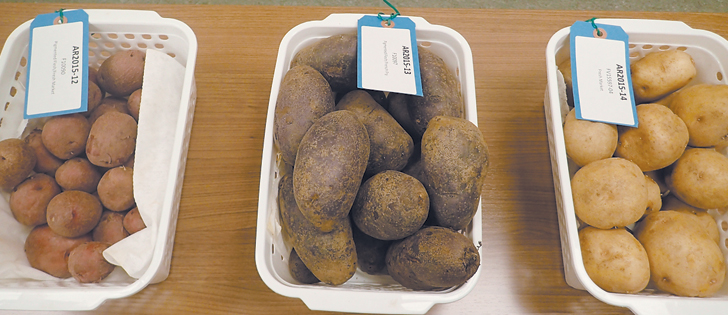Potato growers urged to emphasize the fresh, local aspects, promote new varieties and provide recipes for this versatile, ‘dynamic’ vegetable
Respect the russet!
That ringing endorsement of popular potato varieties was accompanied by a table full of 15 new types now ready for evaluation and licence agreements.
Agriculture Canada had the new varieties on display at the Lethbridge Research Centre Feb. 15 and held a joint video conference involving researchers in Lethbridge, Guelph, Ont. and Fredericton.
Dino Kubik of the market and industry services branch of Agriculture Canada in Fredericton made the russet rallying cry but red-skinned varieties made up the bulk of new choices open to evaluation.
Read Also

Farming Smarter receives financial boost from Alberta government for potato research
Farming Smarter near Lethbridge got a boost to its research equipment, thanks to the Alberta government’s increase in funding for research associations.
The Agriculture Canada variety process involves four phases that allow the potato industry to evaluate varieties and later bid on those they want to explore further. That leads to negotiation of licence agreements and then commercialization.
Benoit Bizimungu, lead potato researcher, said 10 of the new varieties are suitable for the fresh market, three are most suitable for french fries and two have dual use.
He told those gathered at the three sites that work continues on breeding potatoes that are resistant to late blight, verticillium wilt and Colorado potato beetle, among other threats, in efforts to reduce reliance upon and use of pesticides.
In his presentation, Kubik said potatoes have made the transition from basic calorie providers to the bearers of flavour and taste.
“I think there’s a new respect for the russets out there,” he said.
North American consumption of potatoes bottomed out in about 1960 but has seen steady if slow growth since then. However, potatoes remain the number one vegetable consumed in both Canada and the United States.
“The potato is dynamic,” he said, noting the many ways it can be prepared and consumed.
Like other foods, spuds and their varieties are subject to trends. In 2008, Yukon Gold was a hot trend and since then data indicates a 12 percent increase in retail sales of yellow potatoes, Kubik said.
In the United States, potatoes with pigmented flesh including purple are rising in popularity, although they remain a small percentage of the overall market.
He provided U.S. figures indicating 48 percent of retail potatoes are sold as french fries, 34 percent as fresh and the balance in dehydrated form.
The current trend toward food chains providing “all day breakfast” could bode well for potatoes, he added. So could vegetable-centred dining and consumer desires for local food.
“There’s no other vegetable that looks as local as you guys do,” he said.
Potatoes are perceived as being less processed as many other foods, and therefore are often perceived as healthier.
He advised potato marketers to emphasize the fresh and unprocessed aspects of potatoes, pay attention to food trends and provide recipes to service them, and promote new varieties.
Kubik also noted a retail consumer trend toward smaller bags of potatoes and a general move toward yellow and red potatoes over whites.
“Retailers are crying for assortment,” said Kubik.


















